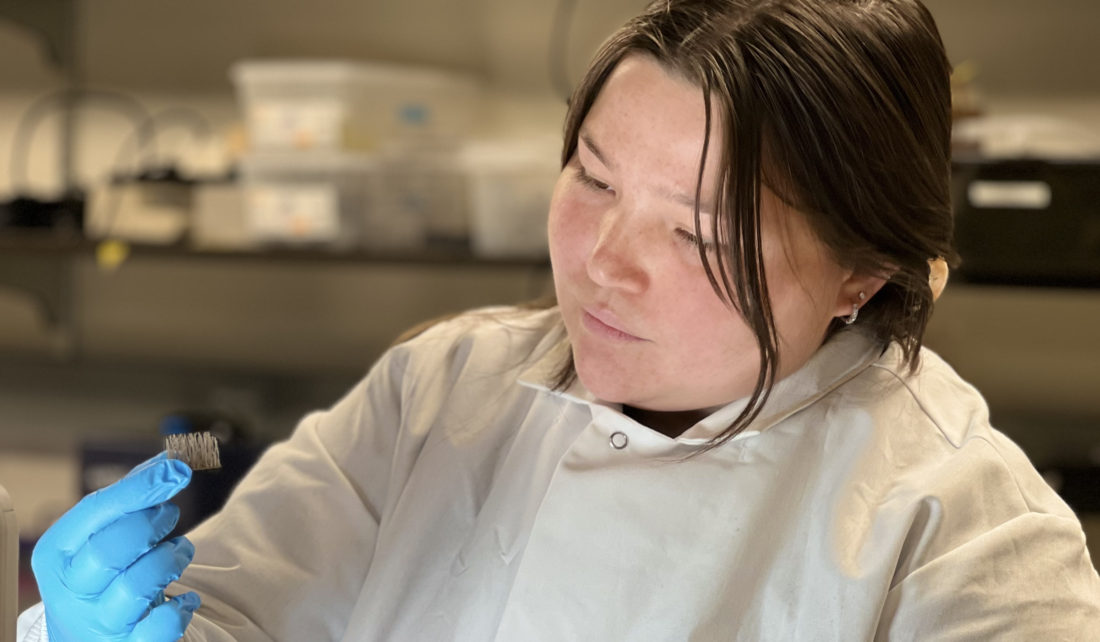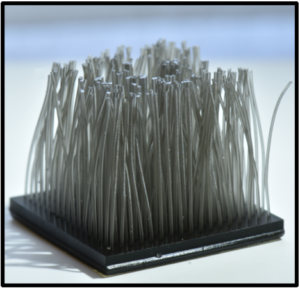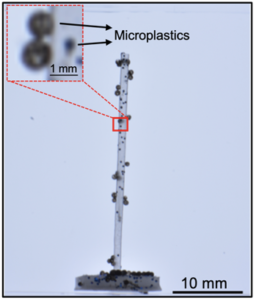
Meet Our Grad Student Scholars is a series from Illinois-Indiana Sea Grant (IISG) celebrating the students and research funded by our scholars program. To learn more about our faculty and graduate student funding opportunities, visit Fellowships & Scholarships.
Chloe Ho is a third-year PhD candidate in the Department of Mechanical Engineering at Northwestern University. Ho works in the Park Lab, investigating a new approach to capturing microplastics in air and water. She is currently working on a project funded by IISG that uses 3D-printed, macrotextured surfaces to efficiently filter microplastics from waterways to support resilient and healthy ecosystems.
Plastics are one of the most revolutionary innovations of modern times. These materials play a critical role in the economy and daily lives of people. They can be found in many places like medical equipment, food packaging, clothing, and toys. Most plastics are durable and do not biodegrade in the environment. While not all plastic items become pollutants, all plastic items have the potential to enter the environment if improperly disposed of. During production or the breakdown of plastics, smaller pieces of plastic are made and released into their surroundings. Plastic debris less than five millimeters in length has been termed “microplastics.”

This 3D-printed array of hairs is inspired by baleen whales, which are filter feeders.
Microplastics pose a severe pollution hazard to the environment and health risks to humans and other organisms due to their ubiquitous nature. Sources for these small particles come from a wide range of sectors, touching almost all aspects of modern life. Primary pathways of microplastics to the environment include personal care products, shedding of synthetic textiles, stormwater runoff, and ultimately the breakdown of larger plastic material. These plastics are commonly found in the air and water, and filtering such plastics is challenging due to the expansive range of particle size, shape, and chemical composition. This combination of factors presents a serious risk of accumulation and exposure to these materials could lead to detrimental health risks to all things living.
Nearly 90% of samples taken from the surface of the Great Lakes exceeded safe levels of microplastics per kilometer for wildlife and people. This is increasingly worrisome due to 21% of the world’s surface freshwater is contained in the Great Lakes and nearly 40 million people depend on the Great Lakes for drinking water. However, due to the challenging characteristics of microplastics, they often make their way through water treatment facilities uncaptured.

This 3D-printed single hair, coated with oil and placed in water, shows the performance of a single hair in capturing microplastics.
Motivated by Lake Michigan being in our backyard at Northwestern University, in the Park Lab, we have been excitingly working towards a hairy filter to capture and remove microplastics from waterways. The inspiration is filter feeders like baleen whales, whose main food source (krill) is many times smaller than the whale and its baleen, or filter, is used to capture the krill. The long fibers of the baleen provide large surface areas for increased contact and interaction between the capturing mechanism and its prey. This increased effective contact area and other surface characteristics is what inspired us to engineer hair-like structures for capturing microplastics. Remarkably, this technology provides several avenues for development that can suit a vast range of applications.
With commercial 3D printers, fabricating filters with hairs can be widely accessible and feasibly scaled up to an industrial level. This method of fabrication allows for precise sample parameters that can be easily modified to tune the filter for specific needs. The geometry, aspect ratio, number and density of hairs, size, etc. can all be edited to elicit certain requirements for the application.
Chloe Ho aims to continue a study that is focused on how to tune the filters for increased efficiency including testing filters in various environments. “It is a bit of a dance–I am learning to find the sweet spot between all the different variables (hair parameters, flow characteristics, particle composition, etc.),” she said.
So far, this work has shown results towards a promising technology that is low-cost, accessible, non-toxic, and reusable. Ho added, “I am excited to keep researching and understanding how hairs can be used to capture microplastics. I strive for a sustainable future for all and hope to provide support towards achieving this.”
___________________________________________________________________________
Illinois-Indiana Sea Grant is one of 34 Sea Grant programs supported by the National Oceanic and Atmospheric Administration in coastal and Great Lakes states that encourage the wise stewardship of our marine resources through research, education, outreach and technology transfer. In partnership with the University of Illinois Extension, and Purdue University Forestry and Natural Resources, Illinois-Indiana Sea Grant brings science together with communities for solutions that work.

